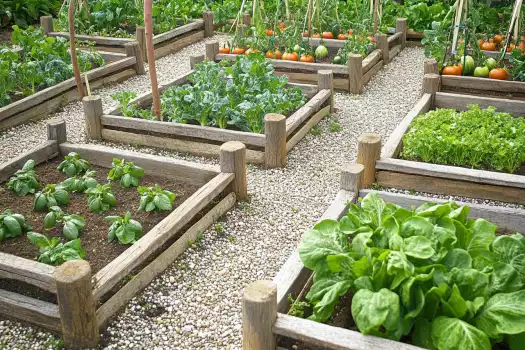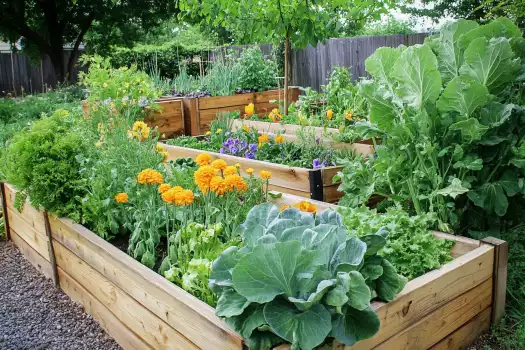Raised bed gardening is one of the most efficient ways to maximize vegetable yield while making the best use of your space. Whether you’re a beginner or an experienced gardener, this guide will help you select the best vegetables for raised beds and offer tips on how to get the most out of your garden.
1. Why Choose Raised Bed Gardening for Maximum Yield?
Raised beds offer several advantages that can help increase your vegetable yield, from better soil control to improved drainage.
Benefits:
- Soil Control: You can customize the soil in raised beds for optimal growing conditions.
- Drainage: Raised beds drain more efficiently, reducing the risk of root rot.
- Easier Access: Gardening in raised beds is more accessible and reduces strain on your back.

2. Key Factors to Consider When Selecting Vegetables for Raised Beds
Choosing the right vegetables for raised bed gardening involves considering factors like plant size, climate, and sunlight.
Key Considerations:
- Compact vs. Full-Size Crops: Compact varieties, like baby carrots or dwarf tomatoes, are ideal for smaller beds.
- Climate and Space: Choose vegetables suited to your region’s climate and the available space in your raised bed.
- Sunlight and Water: Ensure that your raised beds receive at least 6 hours of sunlight and have proper water management.
3. Top High-Yield Vegetables for Raised Bed Gardening
1. Leafy Greens (Lettuce, Spinach, Kale)
These fast-growing vegetables thrive in raised beds, and you can harvest them continuously throughout the season.
2. Vining Plants (Cucumbers, Pole Beans)
Vining plants use vertical space efficiently, allowing you to grow more in a compact area with the help of trellises.
3. Root Vegetables (Carrots, Beets, Radishes)
Raised beds with deep soil are ideal for growing root vegetables, allowing them to grow straight and long.
Learn more about growing carrots from seed here.
4. Tomatoes
Tomatoes are highly productive in raised beds, especially when staked or caged to support their growth.
5. Squash and Zucchini
These vegetables can provide a large yield with adequate spacing, making them perfect for raised beds with enough room.
6. Peppers (Bell and Hot Peppers)
Peppers are compact and high-yielding, making them ideal for raised bed gardens, even in small spaces.

4. How to Maximize Vegetable Yield in Raised Beds
Getting the most out of your raised bed garden requires strategic planting and gardening techniques.
1. Companion Planting
Companion planting pairs certain vegetables together to improve growth and prevent pests. For example, planting marigolds alongside tomatoes helps deter harmful insects.
2. Succession Planting
Ensure continuous harvests by planting fast-growing vegetables like lettuce in succession, every few weeks.
3. Vertical Gardening and Trellising
Maximize space by growing vining plants like cucumbers or beans vertically, using trellises or stakes.
4. Intensive Planting Methods
By planting crops closer together in raised beds, you can maximize productivity while minimizing wasted space.
5. Best Soil and Compost for Raised Bed Gardening
The foundation of a productive raised bed garden is high-quality, nutrient-rich soil. Here’s how to build and maintain the best soil for your vegetables.
1. Building the Ideal Soil Mix
Create a balanced soil mix with loamy soil, compost, and organic matter. Well-draining soil is essential for preventing waterlogging.
2. Adding Organic Matter and Compost
Incorporate compost regularly to boost soil fertility and promote healthy plant growth. This is particularly important for nutrient-hungry plants like tomatoes.
External Resource: For more ideas on high-yield vegetables and maximizing your raised bed productivity, check out this guide.
6. Common Raised Bed Gardening Mistakes and How to Avoid Them
Even experienced gardeners make mistakes. Here are some common issues and how to avoid them:
1. Overcrowding Plants
Planting too many vegetables in a raised bed can lead to competition for nutrients and reduced yields. Space your plants according to their needs.
2. Ignoring Soil Quality
Neglecting to amend your soil with organic matter or compost can lead to nutrient deficiencies.
3. Not Rotating Crops
To avoid soil depletion and pests, practice crop rotation by planting different types of vegetables in different areas of your raised bed each year.
7. Best Layout and Design Tips for Raised Bed Gardens
Designing your raised bed layout is essential for optimizing space, providing proper drainage, and ensuring easy access to all your vegetables.
1. Planning Your Raised Bed Layout
Group plants with similar water and sunlight needs together. Use taller plants like tomatoes to provide shade for more delicate crops like lettuce.
2. Raised Bed Sizes and Depths
The size of your raised bed should accommodate the types of vegetables you plan to grow. For example, root vegetables need deeper beds, while shallow-rooted plants like lettuce can thrive in more shallow beds.
3. Irrigation and Drainage Tips
Install drip irrigation or soaker hoses to water your raised bed evenly and efficiently. Ensure proper drainage to prevent root rot and overwatering.
8. Frequently Asked Questions
Q: What vegetables grow best in raised beds?
A: Leafy greens, root vegetables, tomatoes, and peppers are all excellent choices for raised beds due to their compact growing habits and high yield potential.
Q: Can I grow root vegetables in raised beds?
A: Yes, raised beds are perfect for root vegetables like carrots, beets, and radishes, especially if you have deep, loose soil.
Q: How often should I water my raised bed garden?
A: Water your raised bed when the top inch of soil feels dry. Raised beds may need more frequent watering due to better drainage.
Q: Can I grow vegetables in a raised bed year-round?
A: With the right planning and protective measures like row covers, many vegetables can be grown year-round in raised beds, depending on your climate.
Conclusion
Raised bed gardening is an excellent way to maximize your vegetable yield, offering control over soil conditions and efficient use of space. By selecting the right crops, employing smart planting techniques, and providing proper care, you can enjoy a productive and rewarding garden.


1 thought on “Best Vegetables for Raised Bed Gardening: Maximize Your Yield”